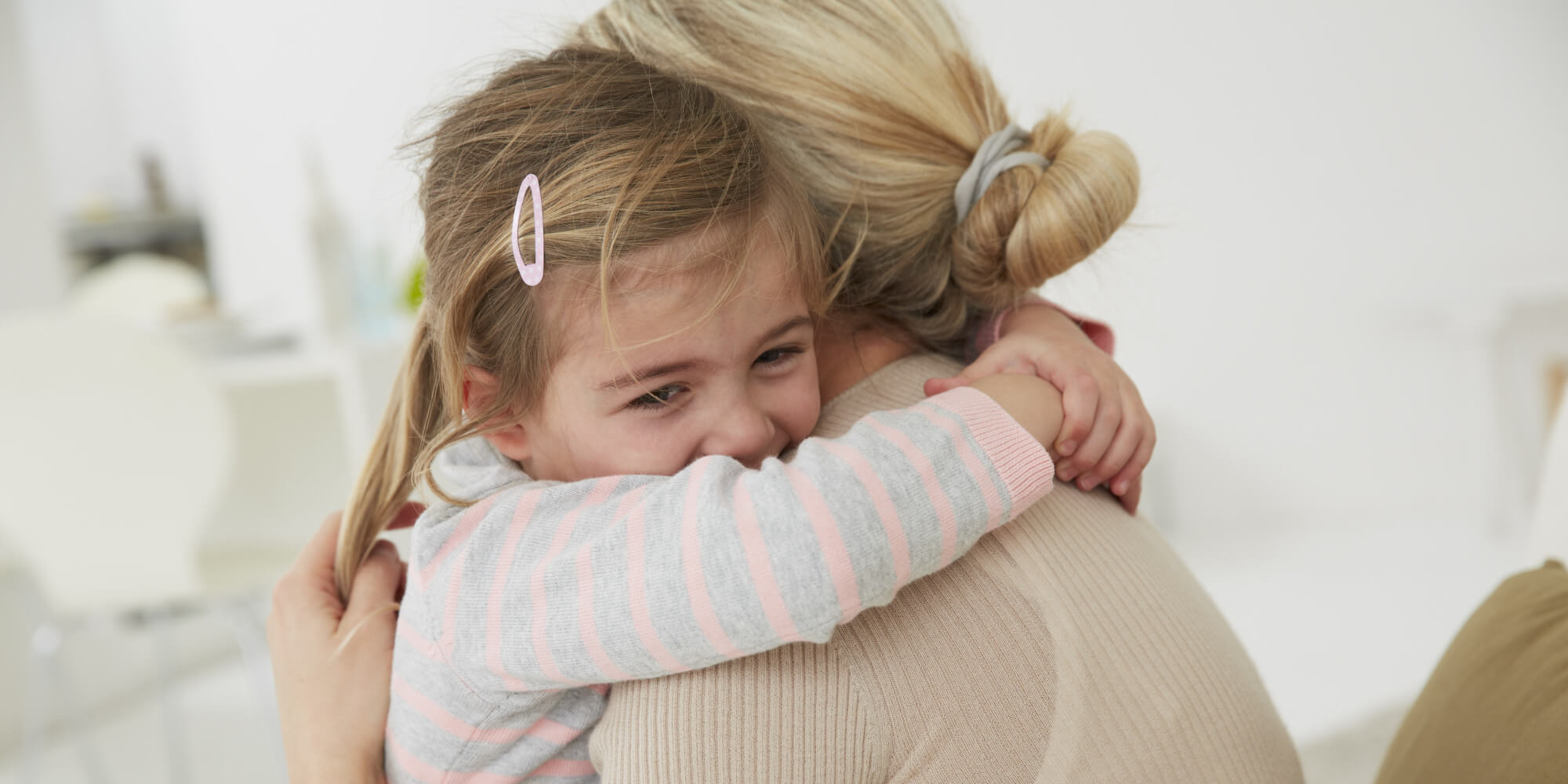Childhood Fears and How to Overcome Them

We can surely all remember our childhood fears, whether it was spiders, snakes or the dark. How can we help our children overcome them? We’ll provide some advice below.
Children can often feel small and vulnerable when they see the size of the world around them. It’s quite normal for them to experience certain fears. Their behavior evolves as they age and so do they.
But how can they deal with their fears, and how can we help them? Which are the most common childhood fears? And at what age do they appear?
Fear is a universal sensation. Regardless of gender, beliefs or age, it’s always there. Darkness, noises, danger; there are countless things or situations that can unleash it.
If we experience it as adults, imagine how much more so must children. They’re often unable to separate the real from the imaginary, and are vulnerable to the unknown. Children’s characters, personalities, surroundings and experiences affect their fears and how they face them.
Childhood fears tend to appear from 6 to 12 months of age, and these intensify between the ages of 3 and 6. What should we do to help them? First we have to treat them with love, understanding and patience. Only then can they learn to face their fears and overcome them.
What are childhood fears?
An important factor to consider is that childhood fears don’t last forever. As children grow (in age and learning) they can learn to overcome them. Although some may interfere with their development, common fears help them to be more cautious in life.
It’s clear that many children experience their first fear in the event of their parents separating. Contact with strangers is also a focus of their fear. However, there are many more.
Here are three of the most common childhood fears:
1. Fear of the dark
Stories about ghosts, witches and supernatural themes are inappropriate for young children. When seen in the evening, children could recreate those tales in their dreams or perceive non-existent sounds and shadows. Because of this, you have to be careful with everything you tell and show them.
Staying in a new place, like the room of a new house, can generate similar sensations. This can even lead to another common fear: the fear of sleeping alone. Leaving a light on, comforting them, and speaking with affection will make the fear disappear.
2. Fear of animals
There are animals all around us. Dogs, cats, parrots, snakes, spiders, fish, among others, can sometimes even be considered members of the family. However, for children they will be strange and potentially harmful beings. It’s not unusual for them to react by crying and with fright when they see them at first. They need to familiarize themselves with them little by little.
Even from an early age, we should show them photos or videos of different animals. We can tell stories about them and help them approach the animals bit by bit. We should encourage them to pet them, but it must be done naturally, without forcing the issue, and their safety must always be a priority.

3. Fear of rain, thunder and lightning
Because these forces of nature are so common in many places, it’s vital that children get used to them. Let them appreciate the rain and the storms. Make sure all doors and windows are closed. Explain to them their importance for our environment – they should simply consider them as something normal.
Other childhood fears, according to age
Fears can grow up with children. They vary as children grow and their emotional, physical and cognitive characteristics change. Not all infants deal with them in the same way, even if they’re the same age. A parent’s duty, therefore, is to learn to recognize them, and to help the child overcome them.
These childhood fears shouldn’t be emphasized, nor should they be used to “protect” or punish children. Pretending to control unfounded behavior can be counterproductive. The best thing is to get informed and seek advice if you think some fears have become out of control.
Here’s a breakdown of common childhood fears according to age:
- From 6 to 12 months. They’re startled by the loss of balance, people outside of their immediate social circle, separation from their parents, noises, bright lights, falls and visits to the doctor.
- From 2 years of age. They’re disturbed by the dark, animals, wounds, the unknown and being away from their parents.
- Between 3 and 4 years old. It’s a stage where fears can take hold considerably. Their imagination makes them frightened of monsters and the dark. They worry about their parents’ threats coming true. And the first worries about death begin to arise.
- From 5 to 7 years old. They fear rejection, failure, people with abnormal features, physical damage and supernatural beings. They still hate being separated from their parents.

Some final advice
We should listen to our children. They should be approached with trust, love and encouragement in order to face these fears gradually. It will help them greatly if we can raise their sense of self-esteem, confidence and independence.
Leading by example also works, but an infallible remedy against fear is humor. Transforming these fears into jokes, drawings and laughter will decrease a child’s stress and worry levels.
What should never be done is to brush their fears aside. Childhood fears should never be ignored. In certain circumstances they may be indications of difficult situations they’re going through. However, we shouldn’t go over the top in helping them, nor should we ever mock or admonish them, nor compare them with others.
We can surely all remember our childhood fears, whether it was spiders, snakes or the dark. How can we help our children overcome them? We’ll provide some advice below.
Children can often feel small and vulnerable when they see the size of the world around them. It’s quite normal for them to experience certain fears. Their behavior evolves as they age and so do they.
But how can they deal with their fears, and how can we help them? Which are the most common childhood fears? And at what age do they appear?
Fear is a universal sensation. Regardless of gender, beliefs or age, it’s always there. Darkness, noises, danger; there are countless things or situations that can unleash it.
If we experience it as adults, imagine how much more so must children. They’re often unable to separate the real from the imaginary, and are vulnerable to the unknown. Children’s characters, personalities, surroundings and experiences affect their fears and how they face them.
Childhood fears tend to appear from 6 to 12 months of age, and these intensify between the ages of 3 and 6. What should we do to help them? First we have to treat them with love, understanding and patience. Only then can they learn to face their fears and overcome them.
What are childhood fears?
An important factor to consider is that childhood fears don’t last forever. As children grow (in age and learning) they can learn to overcome them. Although some may interfere with their development, common fears help them to be more cautious in life.
It’s clear that many children experience their first fear in the event of their parents separating. Contact with strangers is also a focus of their fear. However, there are many more.
Here are three of the most common childhood fears:
1. Fear of the dark
Stories about ghosts, witches and supernatural themes are inappropriate for young children. When seen in the evening, children could recreate those tales in their dreams or perceive non-existent sounds and shadows. Because of this, you have to be careful with everything you tell and show them.
Staying in a new place, like the room of a new house, can generate similar sensations. This can even lead to another common fear: the fear of sleeping alone. Leaving a light on, comforting them, and speaking with affection will make the fear disappear.
2. Fear of animals
There are animals all around us. Dogs, cats, parrots, snakes, spiders, fish, among others, can sometimes even be considered members of the family. However, for children they will be strange and potentially harmful beings. It’s not unusual for them to react by crying and with fright when they see them at first. They need to familiarize themselves with them little by little.
Even from an early age, we should show them photos or videos of different animals. We can tell stories about them and help them approach the animals bit by bit. We should encourage them to pet them, but it must be done naturally, without forcing the issue, and their safety must always be a priority.

3. Fear of rain, thunder and lightning
Because these forces of nature are so common in many places, it’s vital that children get used to them. Let them appreciate the rain and the storms. Make sure all doors and windows are closed. Explain to them their importance for our environment – they should simply consider them as something normal.
Other childhood fears, according to age
Fears can grow up with children. They vary as children grow and their emotional, physical and cognitive characteristics change. Not all infants deal with them in the same way, even if they’re the same age. A parent’s duty, therefore, is to learn to recognize them, and to help the child overcome them.
These childhood fears shouldn’t be emphasized, nor should they be used to “protect” or punish children. Pretending to control unfounded behavior can be counterproductive. The best thing is to get informed and seek advice if you think some fears have become out of control.
Here’s a breakdown of common childhood fears according to age:
- From 6 to 12 months. They’re startled by the loss of balance, people outside of their immediate social circle, separation from their parents, noises, bright lights, falls and visits to the doctor.
- From 2 years of age. They’re disturbed by the dark, animals, wounds, the unknown and being away from their parents.
- Between 3 and 4 years old. It’s a stage where fears can take hold considerably. Their imagination makes them frightened of monsters and the dark. They worry about their parents’ threats coming true. And the first worries about death begin to arise.
- From 5 to 7 years old. They fear rejection, failure, people with abnormal features, physical damage and supernatural beings. They still hate being separated from their parents.

Some final advice
We should listen to our children. They should be approached with trust, love and encouragement in order to face these fears gradually. It will help them greatly if we can raise their sense of self-esteem, confidence and independence.
Leading by example also works, but an infallible remedy against fear is humor. Transforming these fears into jokes, drawings and laughter will decrease a child’s stress and worry levels.
What should never be done is to brush their fears aside. Childhood fears should never be ignored. In certain circumstances they may be indications of difficult situations they’re going through. However, we shouldn’t go over the top in helping them, nor should we ever mock or admonish them, nor compare them with others.
All cited sources were thoroughly reviewed by our team to ensure their quality, reliability, currency, and validity. The bibliography of this article was considered reliable and of academic or scientific accuracy.
- Ollendick, T. H.; King, N. J.; Frary, R. B. (1989). Fears in children and adolescents: Reliability and generalizability across gender, age and nationality. Behavior Research and Therapy. 27:19-26
- Pelechano, V. (1981). Miedos infantiles y terapia familiar. Valencia: Alfaplus.
- Sandín, B., & Chorot, P. (1998). Dimensiones de los miedos en niños: Estructura factorial del FSSC-R. Psiquis, 19(1), 23-32. https://www.researchgate.net/profile/Bonifacio_Sandin/publication/285732793_Dimensions_of_fears_in_children_Factor_structure_of_the_FSSC-R/links/59ad46e0458515d09ce16c65/Dimensions-of-fears-in-children-Factor-structure-of-the-FSSC-R.pdf
- Sandín, B., Chorot, P., Valiente, R. M., & Germán, M. Á. S. (1998). Frecuencia e intensidad de los miedos en los niños: Datos normativos. Revista de Psicopatología y Psicología Clínica, 3(1), 15-25. http://revistas.uned.es/index.php/RPPC/article/view/3853
- Valiente, R. M., Sandín, B., & Chorot, P. (2002). Miedos comunes en niños y adolescentes: Relación con la sensibilidad a la ansiedad, el rasgo de ansiedad, la afectividad negativa y la depresión. Revista de psicopatología y Psicología clínica, 7(1), 61-70. http://revistas.uned.es/index.php/RPPC/article/view/3922
This text is provided for informational purposes only and does not replace consultation with a professional. If in doubt, consult your specialist.








